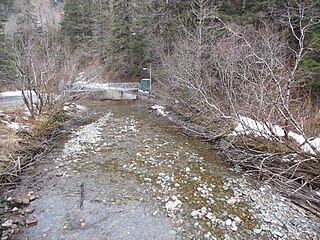External links
| | This article about a United States businessperson is a stub. You can help Wikipedia by expanding it. |
This article related to Juneau, Alaska is a stub. You can help Wikipedia by expanding it. |
John F. Maloney (sometimes spelled Malony) (died 1918) was an Alaskan lawyer, businessman, and politician, including the first Mayor of Juneau, Alaska from 1905 to 1906. He came to Juneau in 1885, and by 1900 owned part the Porcupine Trading Company, after the 1898 Porcupine Gold Rush (), along with Jack Dalton and Ed Hanley.
Maloney is best known for being one of the founders of the Alaska Electric Light & Power (AEL&P), an important Juneau business since 1893. He was also affiliated with the Treadwell Gold Mine, representing the mine's company in legal issues. Maloney was the president of AEL&P from 1905 until his death.

Southeast Alaska, often abbreviated to Southeast or Southeastern, and sometimes called the Alaska(n) Panhandle, is the southeastern portion of the U.S. state of Alaska, bordered to the east and north by the northern half of the Canadian province of British Columbia. The majority of Southeast Alaska is situated in Tlingit Aaní, much of which is part of the Tongass National Forest, the United States' largest national forest. In many places, the international border runs along the crest of the Boundary Ranges of the Coast Mountains. The region is noted for its scenery and mild, rainy climate.

The City and Borough of Juneau, more commonly known simply as Juneau, is the capital city of the U.S. state of Alaska. Located in the Gastineau Channel and the Alaskan panhandle, it is a consolidated city-borough and the second-largest city in the United States by area. Juneau was named the capital of Alaska in 1906, when the government of what was then the District of Alaska was moved from Sitka as dictated by the U.S. Congress in 1900. The municipality unified on July 1, 1970; the city of Juneau merged with the city of Douglas and the surrounding Greater Juneau Borough to form the current municipality, which is larger by area than both Rhode Island and Delaware.

Alaska Electric Light & Power, also known as AEL&P, is the power utility for Juneau, the capital city of Alaska. AEL&P gets their electricity primarily through the Snettisham hydroelectric power plant, located in an uninhabited region 30 miles (48 km) Southeast of downtown Juneau, accessible only by boat and aircraft. The General Manager for the company is Connie Hulbert.

The Treadwell gold mine was on the south side of Douglas Island, .5-mile (0.80 km) east of downtown Douglas and southeast of downtown Juneau, owned and operated by John Treadwell. Composed of four sub-sites, Treadwell was in its time the largest hard rock gold mine in the world, employing over 2,000 people. Between 1881 and 1922, over 3 million troy ounces of gold were extracted. Not much remains today except for a few crumbling buildings and a "glory hole". Although John Treadwell had twelve years of experience in both placer and lode mines, he was a carpenter and builder by trade who had come to Alaska prior to the Klondike Gold Rush.
Gold mining in Alaska, a state of the United States, has been a major industry and impetus for exploration and settlement since a few years after the United States acquired the territory in 1867 from the Russian Empire. Russian explorers discovered placer gold in the Kenai River in 1848, but no gold was produced. Gold mining started in 1870 from placers southeast of Juneau, Alaska.
The Juneau mining district is a gold mining area in the U.S. state of Alaska.
Coeur Alaska, Inc. v. Southeast Alaska Conservation Council, 557 U.S. 261 (2009), is a United States Supreme Court case that was decided in favor of Coeur Alaska's permit to dump mine waste in a lake. The case addressed tailings from the Kensington mine, an underground mine located in Alaska. The gold mine had not operated since 1928, and Coeur Alaska obtained a permit in 2005 from the United States Army Corps of Engineers (USACE) to dispose of up to 4.5 million tons of tailings in Lower Slate Lake, which is located in a National Forest.
Snettisham is a locale and former populated place in the City and Borough of Juneau, Alaska, United States. Based on the mainland coast of Stephens Passage, it is 31 miles (50 km) southeast of the city of Juneau. The area was named by George Vancouver in 1794; the bay on which Snettisham was located was named for the village of Snettisham in Norfolk, England. It was established as a gold- and silver-mining camp around 1895, its operations being linked to those in the immediate Juneau area, and it remained a small harbor village until 1926. The United States Department of the Treasury designated Snettisham as one of several of Alaska's "special" landing places for vessels carrying "coal, salt, railroad iron, and other like items in bulk". The designation was meant to encourage the construction of facilities to accommodate these shipments, thus stimulating creation and growth of local businesses.

The Salmon Creek Dam is a concrete arch dam on the Salmon Creek, 3 miles (5 km) northwest of Juneau, Alaska. Built in 1914, it is the world's first constant-angle arch variable radius dam. Since it was built, over 100 such dams have been constructed all over the world. The dam was designated as a National Historic Civil Engineering Landmark by the American Society of Civil Engineers in 2022.

Gold Rush is a reality television series that airs on Discovery and its affiliates worldwide. The series follows the placer gold mining efforts of various family-run mining companies, mostly in the Klondike region of Dawson City, Yukon, Canada, as well as in the U.S. state of Alaska. In its 12th season as of early 2021, prior seasons also included mining efforts in South America and western North America.
The Alaska-Gastineau Mining Co. had its offices in 25 Broad St., New York City, New York. It was the operating company for the Alaska Gold Mines Co. in Alaska. It worked the Alaska-Gastineau Mine/Perseverance Mine in the Silver Bow Basin, approximately 4 miles (6.4 km) from Juneau and processed its ore at an old remodeled mill and crushing plant at Sheep Creek. The property of the Alaska Juneau Gold Mining Co. adjoined the Alaska Gastineau on the west.
Bartlett Lee "Bart" Thane was an American mining engineer who pioneered hydroelectric power in Juneau, Alaska. The world's first thin arch dam, Salmon Creek Dam, was constructed by Thane.

The Silver Bow Basin, often written as Silverbow Basin, is a valley located 2.4 miles (3.9 km) northeast of Juneau, Alaska, USA. It is situated on Gold Creek in an area north of Icy Gulch, and approximately 1.5 miles (2.4 km) north of Gastineau Peak. A trail from Juneau leads directly to the mountainside. The basin was the site of the earliest gold discovery in the Juneau area, leading to the establishment of the town called Juneau.

The Alaska-Juneau Gold Mining Company (AJGMC) was incorporated under the laws of West Virginia, USA in 1897. Its lode mining claims covered approximately 402.37 acres (162.83 ha) on the wide vein called the Juneau gold belt of which it owned one mile on the outcrop.
Crystal Mine is located near Juneau in the U.S. state of Alaska. The quartz ledge at the Crystal Mine was first discovered in 1895 by B. Heins. It was so named because of the large pyrite cubes which were found occurring in the surface outcrops of the ledge. Gold was extracted till 1905 from quartz using ten-stamp mill and from about 1,000 feet of underground workings yielded 1,210 ounces of gold. Intermittent production of gold is reported till 1925 but there are no records of the yield. The formation was determined as of 54 to 56 Ma age. The gold yielding resources available from the mine were assessed as 9,000 tons of material with yield of 0.21 ounce of gold per ton.

Port Snettisham is a narrow fjord 30 miles (48 km) southeast of Juneau in the U.S. state of Alaska. It is a semi protected deep water port that was developed to transport many mineral deposits found in the Snettisham Peninsula. Lieutenant Joseph Whidbey of the Royal Navy discovered the fjord on August 12, 1794; George Vancouver named it after the town of Snettisham in England.

The Juneau gold belt is located in the southeastern portion of the U.S. state of Alaska. This belt is approximately 100 miles (160 km) in length, north/northwest-trending, and extends from Berners Bay southeastward to Windham Bay, 60 miles (97 km) southeast of Juneau, and includes Douglas Island. The belt contains over 200 gold-quartz-vein deposits with production nearing 7,000,000 ounces (200,000,000 g) of gold. More than three-quarters of Alaska's lode gold was mined from the Juneau gold belt.

Gold Creek is a waterway in the southeastern section of the U.S. state of Alaska. It is located in Silver Bow Basin at the edge of Juneau. In 1880, Chief Kowee revealed to prospectors Joe Juneau and Richard Harris the presence of gold in Gold Creek; the city of Juneau was founded in the same year. Named by miners, the name was first published in 1883.

Jualin Mine is a defunct gold mine located within the City and Borough of Juneau, Alaska approximately 44 miles (71 km) northwest of downtown Juneau, Alaska. The Jualin gold deposit was discovered by prospector Frank Cook in 1895 and was initially mined by the Jualin Mining Company. A stamping mill with a daily capacity of 30 stone (0.19 t) of ore was installed early in the mine's operation. The mine operated intermittently from 1896 to 1901 and again from 1905 to 1908, when it was closed at a depth of 210 feet due to water infiltration and power shortages. In 1912, the mine was purchased by a Belgian group, which began investing in better equipment and deeper drilling. In 1914, the shaft was deepened to 325 feet, and mining took place at the 310-foot level. A drainage and haulage tunnel was planned to extend 7,800 feet (2,400 m) south of the mine to allow easy access to the mining levels, but the outbreak of World War I halted this effort when the extension was only 5,000 feet (1,500 m) long.
Nikola Bezmalinovic, known as Nick Bez was founder of fishing, canning, and shipping companies in Juneau, Alaska. Nick Bez operated the largest fishing ship at the time the 423-foot, Pacific Explorer. Nick Bez also owned and operated the Nornek cannery, two gold mines, Alaska Southern Packing Company, Peter Pan Seafoods, Alaska Southern Airways, Pacific Exploration Company and the Intercoastal Packing Company as well as West Coast Airlines which became part of Air West. Nick Bez became known as a rags to riches entrepreneur. In 1919 Nikola Bezmalinovic changed his name to Nick Bez. Nick Bez died in 1969.